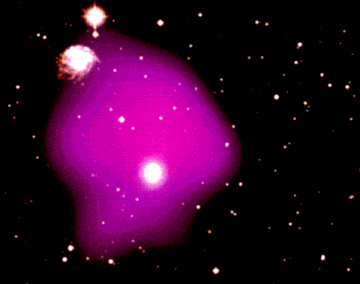Stars today burn bright through the interactions of elements like hydrogen and helium. But was that the same story for the first stars in the universe, or was their light dominated by the annihilation of dark matter? Recently, Ili et al. took up the challenge of finding out what astronomers should be looking for if this is the cas.
Well how could we detect such a thing? Well start by looking at the plot below:
Here we see the predicted "star formation rate" versus redshift predicted by their numerical simulations. What this shows is that the peak star formation of these "dark stars", as they are called, happened at a redshift of around ~12, or ~13 billion years ago, just after the big bang. (Remember, the higher the redshift the farther back in time.)
When an object emits a lot of light a long time ago, two things happen:
- The light becomes redshifted due to the expansion of the universe so that what once was visible light becomes infrared.
- They lose a lot of signal at certain wavelengths due to the Lyman alpha forest. (See plot below).
The plot above shows what happens when you have the combination of 1 and 2, and is the predicted "SED" for these objects meaning, this is how bright the objects are supposed to be at each wavelength. As you can see, one one hand, since these objects are at high redshift, the light they emit at the ultra-violet and visible wavelengths has been redshifted to the infrared. Second, because of the Lyman alpha-forest, you see a drop of below certain wavelengths of light. (If you don't understand all this it's fine, just know there are predictions for how bright these objects should be at each wavelength so we can now go look for something with that pattern.)
Unfortunately, we can stare at these objects at every wavelength. Instead, we have to use powerful telescopes and stare at them at the specific wavelengths of those telescopes and hope for the best. For example, this is a prediction of what Hubble could see in the 1.25 and 1.6 micrometer wavelength bands it has:
The solid red and blue curves are the predictions of the "magnitudes" of these objects in the 1.6 (red) and 1.25 (blue) micrometer bands of Hubble. (Magnitude is a measure of brightness and the smaller the magnitude the brighter the object... not a typo, astronomers do everything backwards...) So if you could find an object at redshift 10 with Hubble with a magnitude of ~28 in the 1.6 micrometer band and ~30 in the 1.25 micrometer band, that could be a good hint.
The next step would be to rule out such an object being a normal star. To do this you use spectroscopy:
Differentiating first galaxies at z>10 from [dark stars] would be possible with spectroscopy: the [dark stars] (which are too cool produce significant nebular emission) will have only absorption lines while the galaxies are likely to produce emission lines as well. .Of particular interest would be the HeII emission lines at λ ∼ 1.6µ as well as Hα lines which would be signatures of early galaxies rather than [dark stars].So there you go: find a high redshift object with the right drop-off in brightness in the right wavelength bands with the right spectroscopy properties and you make have a star, not powered by the interactions of hydrogen and helium like stars today, but may in fact be light from dark matter annihilation similar to the theoretical dark matter annihilation that may have been given off just after the big bang.




No comments:
Post a Comment
To add a link to text:
<a href="URL">Text</a>